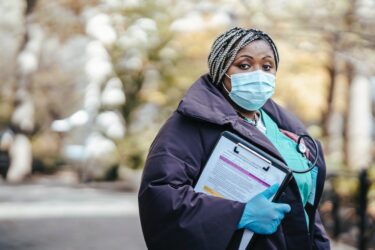Federal officials are acknowledging that patient safety indicators still haven’t rebounded since the pandemic as two new reports stoke concern about a downturn in the quality of care.
On the bright side, tracking data show recent improvement in safety indicators, Michelle Schreiber, M.D., director of the Centers for Medicare and Medicaid Services (CMS) Quality Measurement and Value-Based Incentives Group, said during a public webinar March 6.
She said the agency’s goal is to “return to prepandemic levels by 2025 — in other words next year.”
The webinar, where officials from four federal agencies touted their focus on patient safety, followed the release of a CMS report that showed “significant worsening” of key patient safety measures during the first two years of the pandemic.
The declines in 2020 and 2021 followed several years of improvement.
Meanwhile, nonprofit consulting group ECRI announced in a report that the disruption of the pandemic triggered what it deemed the top safety concern of 2024 — challenges in transitioning newly educated physicians and nurses into clinical care.
For reporters, these developments provide context for covering various aspects of patient safety, including steps that health care providers are taking to improve.
Push for resiliency
President Biden did not mention patient safety in his State of the Union address as some advocates had hoped. Rather, Schreiber and other health officials have been speaking publicly about the administration’s initiatives.
During the webinar, which will be repeated March 21, Schreiber acknowledged the pandemic’s toll: “What this taught all of us is that health care needs to become more resilient, including our safety systems.”
She said that means ensuring that providers achieve “ongoing improvement regardless of circumstances.”
After restoring pre-pandemic safety levels, she said CMS is targeting an additional 25% reduction in patient harms by 2030 with an overall target of “zero harm,” which is part of CMS’s National Quality Strategy.
New federal levers
CMS has numerous levers, including expanded safety measures, targeted quality improvement programs, patient engagement, and Conditions of Participation for Medicare and Medicaid, Schreiber noted.
She mentioned initiatives such a “birthing friendly” designation for hospitals and a patient safety structural measure to assess organizational factors like governance and patient engagement.
Arjun Srinivasan, M.D., deputy director for program improvement in the CDC’s Division of Healthcare Quality Promotion, added that an ongoing shift to digital quality measures will allow the government to track a wider range of safety indicators while improving risk adjustment and unburdening providers.
Meanwhile the Agency for Healthcare Research and Quality (AHRQ) is encouraging health systems to perform baseline self-assessments as part of the National Action Alliance for Patient and Workforce Safety, a public-private collaboration, said Craig A. Umscheid, M.D., M.S., director of that agency’s Center for Quality Improvement and Patient Safety.
AHRQ is also working on a “national healthcare safety dashboard” that would report safety measures by state, provider type, and race and ethnicity, Umscheid said.
Worse infection rates
Schreiber said federal initiatives align with recommendations issued last year by a presidential advisory panel. However, their impact may take years to assess.
The new CMS report shows that health care facilities did a worse job during the pandemic of protecting patients from three serious types of infections: central line-associated bloodstream infection, catheter-associated urinary tract infection and methicillin-resistant staphylococcus aureus.
Hospitals had reported 34,455 fewer cases of those infections from 2015 to 2019, saving an estimated $93.8 million or more. Yet all three were significantly worse than expected during 2020 and 2021.
Similarly, skilled nursing facility fall rates were worse than expected in 2021 (no data were available for 2020) after improving from 2017 to 2019, the report said.
The report is a triennial assessment of the impact of federal quality measures. It noted that the next version, to be released in 2027, will have data to show whether patient safety actually rebounded post-pandemic.
Disruptions in clinician training
Also pushing to reprioritize safety is ECRI, which warned that the pandemic “disrupted the traditional hands-on, in-person educational experiences of new clinicians, an issue compounded by healthcare workforce shortages.”
It cited studies showing that medical residents experienced less procedural education and training in high-risk areas such as surgical specialties, neurology and anesthesia and that nurses faced disruptions in their transition to practice programs.
The group called for an effort to “assess and redesign the environments in which clinicians are trained, onboarded, mentored, and supported.”
ECRI’s annual list of 10 safety concerns emanates from its experts’ assessments of member surveys and reviews of millions of reported patient safety events.
Here are some of its other top hazards for this year:
- Workarounds with barcode medication administration systems.
- Barriers to accessing maternal and perinatal care.
- Unintended consequences of technology adoption.
- A decline in the physical and emotional wellbeing of health care workers.









